Become a better baker by learning the real differences between baking powder and baking soda—in easy-to-understand language!
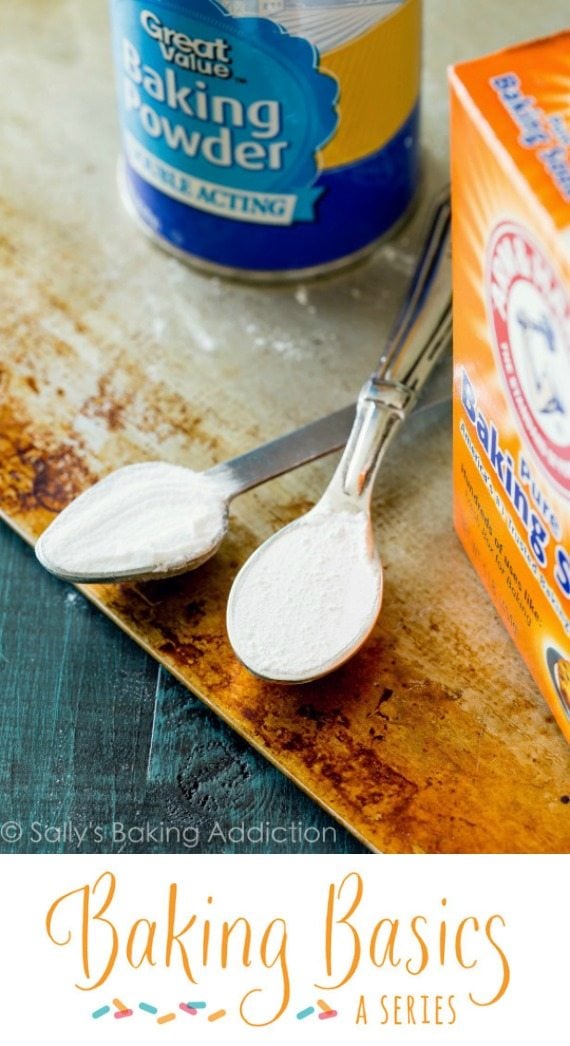
Welcome back to my Baking Basics series!
Today I’m discussing one of the most confusing subjects in the entire realm of baking. What is the difference between baking powder and baking soda? Are they the same? Can I sub one for the other without changing anything else?
If there is one thing that you take away from today’s lesson, let it be this: baking powder and baking soda are absolutely not the same.
Baking powder and baking soda are both leaveners, however they are chemically different.
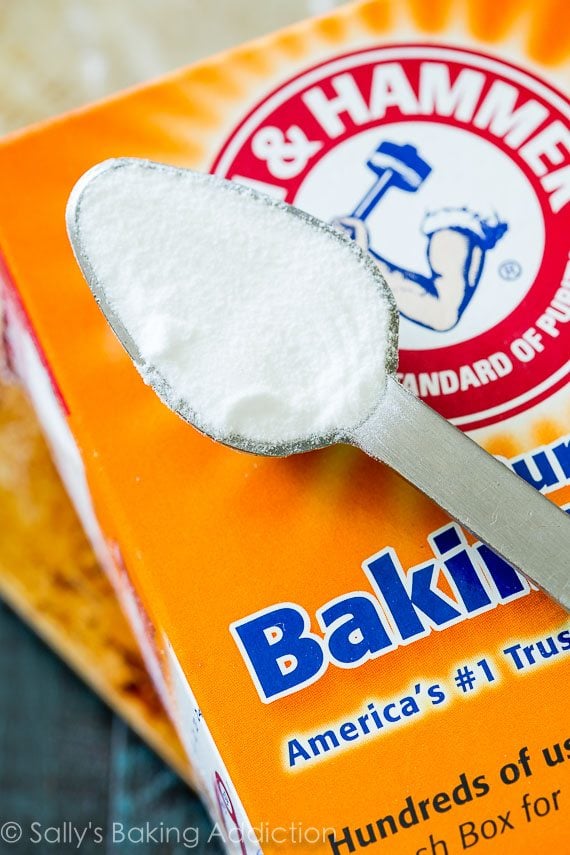
What is Baking Soda?
Aka bicarbonate of soda or sodium bicarbonate.
Let’s start with baking soda because it’s the most confusing. First, baking soda is a BASE. Do you remember the science experiment we all did in school? Mixing baking soda with vinegar and watching an eruption of bubbles? Usually we did this in some sort of model volcano contraption. I know you know. When you mix baking soda (BASE) with vinegar (ACID) you get a chemical reaction (an eruption of bubbles!). A product of this reaction is carbon dioxide.
The same exact reaction happens in our cookies, cakes, breads, etc. When a recipe calls for baking soda (BASE), it usually calls for some type of ACID like buttermilk, brown sugar, yogurt, lemon juice, vinegar, cream of tartar, molasses, applesauce, natural cocoa powder (not dutch process), or honey. You need this ACID in the recipe to react with the baking soda, which in turn creates carbon dioxide and allows your baked good to rise.
Baking soda is strong. In fact, it is about 3-4x stronger than baking powder. More baking soda in a recipe doesn’t necessarily mean more lift. You want to use *just enough* to react with the amount of acid in the recipe. Too much baking soda and not enough acid means there will be leftover baking soda in the recipe. You do not want that; it creates a metallic, soapy taste in your baked goods. Ick.
Good rule of thumb: I usually use around 1/4 teaspoon of baking soda per 1 cup of flour in a recipe.
Baking soda CAN leaven a baked good when exposed to heat. However, unless it is neutralized with an acid, your finished baked good will likely have a metallic aftertaste—like I mention above. Get it? Got it? Good.

What is Baking Powder?
Baking powder contains baking soda. It is a mixture of baking soda, cream of tartar (a dry acid), and sometimes cornstarch. These days, most baking powder sold is double acting. This means that the first leavening occurs when baking powder gets wet—like when you combine the dry and wet ingredients in the recipe. (This is why you cannot prepare some batters ahead of time to bake later—because the baking powder has already been activated.) The second leavening occurs when the baking powder is heated.
Double (first, second) acting.
Since baking powder already contains an acid to neutralize its baking soda, it is most often used when a recipe does not call for an additional acidic ingredient. Like my sugar cookies. However, this isn’t always the case. You can still use baking powder as the leavening agent in recipes calling for an acidic ingredient. Like my lemon blueberry cake. In my recipe development, I based my lemon cake recipe off of my vanilla cake recipe. I used buttermilk (acid) instead of regular milk for added moisture and a little tang and subbed a little brown sugar (acid) for granulated sugar—again, for added moisture. I was pleased with the rise and taste of the cake, so I did not experiment with using baking soda.
Good rule of thumb: I usually use around 1 teaspoon of baking powder per 1 cup of flour in a recipe.
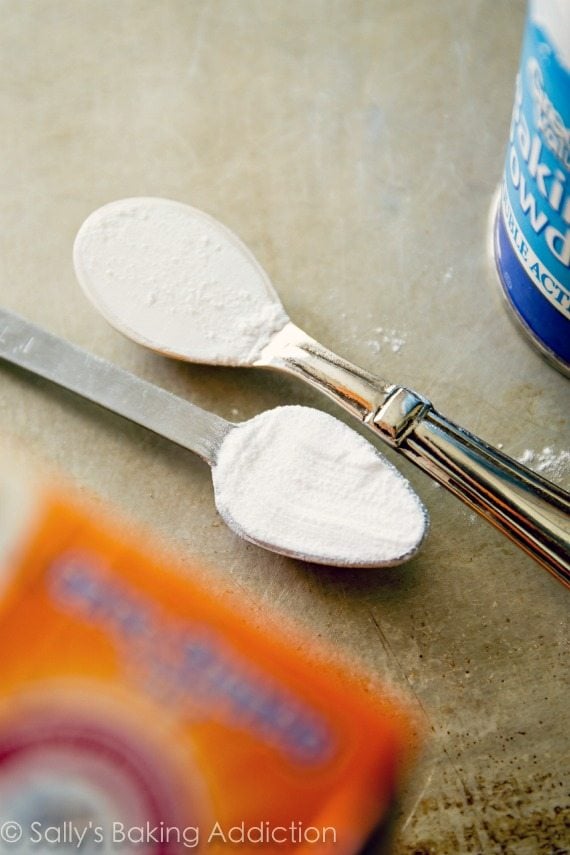
Why do some recipes call for both?
Some recipes call for both baking powder and baking soda. These recipes contain some sort of acid (yogurt, brown sugar, etc), however the carbon dioxide created from the acid and baking soda is not enough to leaven the volume of batter in the recipe. That’s why baking powder is used as well—to add necessary lift.
Basically, the reason for both is because sometimes you need more leavening than you have acid available in the recipe. It’s all about balance.
Another reason to use both baking powder and baking soda is because they affect both browning and flavor. Food & Wine breaks it down easily: let’s take my birthday cake pancakes recipe. In my recipe, buttermilk is used partly for its tangy flavor. If we used only baking soda, it could neutralize all of the buttermilk’s acid. And we’d lose that tanginess! However, by including baking powder as well (which has its own acid), some of the buttermilk’s flavor is left behind, and there is still enough leavening for fluffy pancakes.
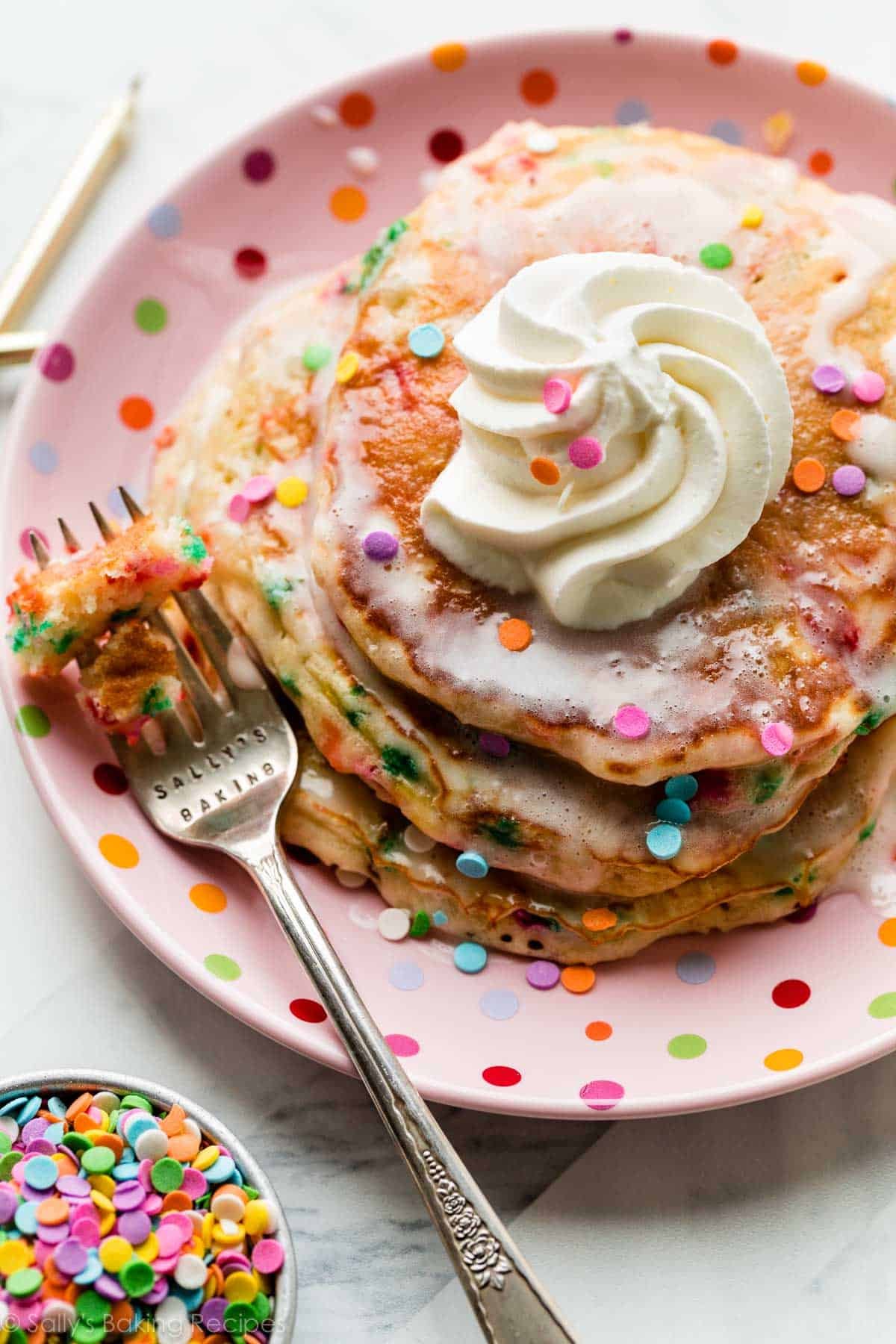
How to Substitute Baking Powder and Baking Soda
It’s tricky, which is why I never recommend it without background knowledge (and the expectancy that your baked good will not taste as intended).
If you have a recipe calling for baking soda, you might be able to substitute baking powder. However, you will need up to 4x as much baking powder to get the same amount of leavening. And, depending on the recipe, you might end up with a baked good that’s a little bitter with that much baking powder. You can sub baking soda for baking powder only if you increase the amount of acid in the recipe—which likely changes the taste and texture of your baked good. You’d also need less baking soda since it is about 3-4x stronger.
So, uh, just stick to the recipe!
Don’t Forget—They Expire!
I replace my baking powder and soda every 3 months, just to be sure they are always fresh for my recipes. I always date them on the bottom of the container. If you don’t bake often, chances are you’ll have to test your baking powder and soda for effectiveness before using.
How To Test Baking Powder
To test baking powder, pour 3 Tablespoons of warm water into a small bowl. Add 1/2 teaspoon of baking powder. Give it a light stir. The mixture should moderately fizz if the powder is fresh. If there is no reaction, toss the baking powder and buy a fresh package.
How To Test Baking Soda
To test baking soda, pour 3 Tablespoons of white distilled vinegar into a small bowl. Add 1/2 teaspoon of baking soda. Give it a light stir. The mixture should rapidly bubble if the soda is fresh. If there is no reaction, toss the baking soda and buy a fresh package.
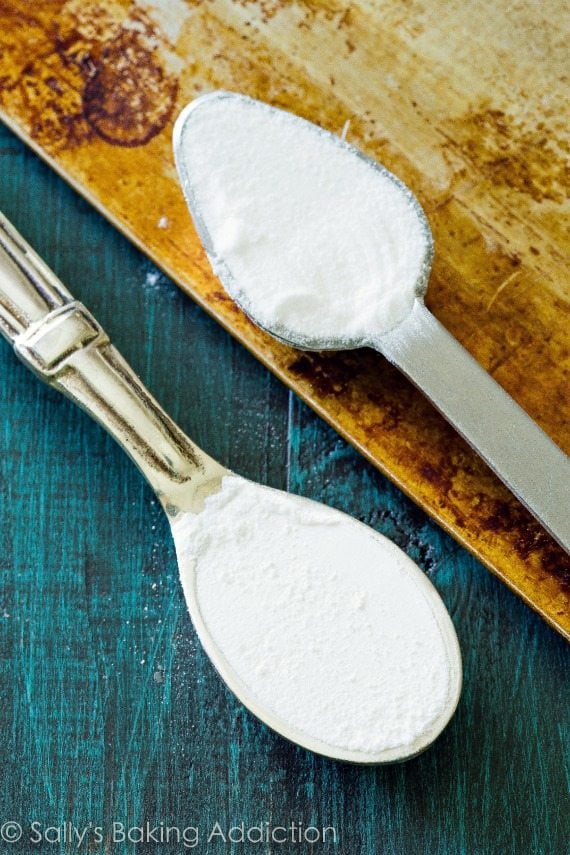
That’s it for today! Did I completely bore you? Hello?
For anyone still here, don’t forget that baking is CHEMISTRY and it takes practice, trial and error, and the willingness to learn in order to succeed.
Stay tuned for a massively tasty chemistry project tomorrow. Cookies!



















Great information, but dare I say I need more! I have been searching for a banana bread recipe that makes 3 or 4 loaves. A lot of home bakers are just tripling or quadrupling recipes… I have read you shouldn’t do that when it comes to baking powder and soda… but can’t find how much I should be using. Can I base the measurements off of pH strips of the batter before the flour and rising agents are added?? Thanks for any additional info you can provide!
Hi Niki, You can double a quick bread recipe like banana bread without changing the ratio of ingredients. We don’t recommend making 3 or 4 times the recipe though. Doing so makes it very easy to over or under mix the ingredients, or overwhelm your mixer.
Your recipes all say salt but never say what kind?
Table salt, kosher salt ( Morton’s or diamond), fine sea salt.
It makes a difference and I don’t know what and how much to use !
Thanks
Hi Rana, my recipes use table salt. I am sure to mention fine sea salt or kosher salt, and which kind, when it is used.
I had a recipe that used 1 1/2 tsp baking soda and 1 1/2 tsp baking powder and regular milk (a cake). I somehow over the years changed it (without realizing) to buttermilk and leaving out the baking powder, and we like it fine. But I found my old recipe so we tried adding the baking powder back in WITH the buttermilk. Made a very soft, light cake, but domed and cracked, so I’m guessing it’s too much leavening. Trying to decide where to cut back…..should I replace the buttermilk with regular milk and go back to equal b p and b s, or should I leave the buttermilk and drop the baking powder? Hard to say based on cakes –they are all good….I’ve made four this week and we just can’t handle any more cake this week! LOL
It always helps me to understand the science behind the things we do. Baking tends to come with ingredients and instructions, but little to no explanation as to why. This was very informative, thank you!
Finally an explanation about the difference between baking soda and baking powder – I have been searching for years – Thank you, Thank you
Now I am ready to bake!
Thank you for the lesson in chemistry, which I never took in any level of school. I especially appreciate how to test baking soda and baking powder to see if they need replacing!
Very well written, but did not explain how it is heat activated. And I thought baking powder expired because the acid and base — being mixed together — eventually reacted and neutralized each other? Individual chemicals on their own (not mixed) — baking soda & cream of tartar — should have a very long shelf life.
Thanks for explaining the difference! I recently started baking, and really enjoy it. Mom always had baking soda and baking powder, but I never knew what the difference was.
I had no idea what these two ingredients did! Outstanding explanation. Thanks.
So very helpful – tested both and need new baking powder, but the soda is fine!
Thank you for explaining this. I am working on updating some family recipes and creating a few of my own and documenting them for our daughters, so understanding the baking powder and baking soda balance is so helpful. Thank you!
I LOVE the science of baking, baking powder vs. baking soda! I learned so much! Thank you
I didn’t e know that one could and should check their soda and powder. Thank you Sally. What is your addiction has now become mine.
you wouldn’t believe how well you cleared some things up for me. thank you.
Your Baking Basics lessons are So helpful! Your website is the place I go to for any questions I have about baking. My Joy of Cooking cookbook does not explain these important basics like you do, or at all…
Thank you Sally!
Do you have a recipe for Zuc.bread?
Hi Joyce, this is my favorite zucchini bread recipe. Enjoy!
wow! this page is incredibly helpful. it clears up so many questions. thank you.
I honestly have learned excellent information from every newsletter.